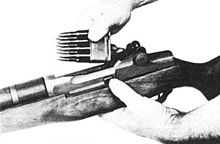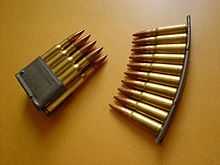Clip (ammunition)

A Stripper clip is a device that is used to store multiple rounds of ammunition together as a unit, ready for insertion into the magazine or cylinder of a firearm. This speeds up the process of loading and reloading the firearm as several rounds can be loaded at once, rather than one round being loaded at a time. Several different types of clips exist, most of which are made of inexpensive metal stampings that are designed to be disposable, though they are often re-used.
The defining difference between clips and magazines is the presence of a feed mechanism in a magazine, typically a spring-loaded follower, which a clip lacks.[1][2][3]
Types
Stripper
A stripper clip or charger is a speed-loader that holds several cartridges together in a single unit for easier loading of a firearm's magazine. A stripper clip is used only for loading the magazine and is not necessary for the firearm to function. It is called a 'stripper' clip because, after the bolt is opened and the stripper clip is placed in position (generally by placing it in a slot on either the receiver or bolt), the cartridges are pressed down, thereby 'stripping' them off of the stripper clip and into the magazine.
En bloc

Several rifle designs utilize an en bloc clip to load the firearm. With this design, both the cartridges and the clip are inserted as a unit into a fixed magazine within the rifle, and the clip is usually ejected or falls from the rifle upon firing or chambering of the last round. The en bloc clip was invented by two firearms inventors working on parallel lines, James Paris Lee for his Lee rifle of 1890, and Ferdinand Mannlicher for use in his M1885 rifle.
Other rifles utilizing a frequently improved en-bloc clip include the German 1888 Commission Rifle, the French 1890 Berthier Cavalry Carbine and later models (upgraded to 5 rounds in 1916), the Italian M1870/87 Vetterli-Vitali and M91 Carcano, the various (Romanian, Dutch, Portuguese) turnbolt Mannlichers, the Austro-Hungarian straight-pull Steyr-Mannlicher M1895, the M1895 Lee Navy, the Hungarian 35M Mannlicher, and the US M1 Garand. Original Austrian Mannlicher clips were often uni-directional, but already the German 1888 Commission Rifle and subsequently the M 91 Carcano employed symmetrical clips, and much later John Pedersen developed an invertible, double-stacked clip for his rifle. This design was also utilized for the competing design by John Garand.[4]
Moon and half-moon

A moon clip is a ring-shaped or stellate piece of metal designed to hold a full cylinder of ammunition for a revolver (generally six rounds) together as a unit. Therefore, instead of loading or extracting one round at a time, a full cylinder of ammunition or spent cases can be loaded or extracted at once, speeding the loading process. A similar device known as the half-moon clip is semi-circular and designed to hold a half cylinder of ammunition (generally three rounds)—in which case two clips are necessary to fully load the cylinder. Such devices have most often been used to chamber rimless semi-automatic pistol cartridges in a revolver.
See also
References
- ↑ "Gun Zone clips vs. magazines". The Gun Zone. Retrieved 2008-06-26.
- ↑ "Magazine". SAAMI. Retrieved 2008-06-26.
- ↑ "Cartridge Clip". SAAMI. Retrieved 2008-06-26.
- ↑ Hogg, Ian V.; Weeks, John S.: (2000) Military Small Arms of the 20th Century, 7th Edition; Krause Publications, ISBN 0-87341-824-7